The Microsoft Surface Book Review
by Brett Howse on November 10, 2015 8:00 AM ESTBattery Life
I would say the average Ultrabook has around 50 Wh of battery capacity. Some have a bit more, and some have a bit less, but 50 Wh would be a good ballpark figure. The Surface Book has a 70 Wh battery, split into 18 Wh in the Clipboard, and 52 Wh in the base. Combined, it gives the Surface Book more battery capacity than any other Ultrabook. However, as I’ve just discussed in the display section, Microsoft has a high resolution panel that is also based on a traditional amorphous silicon TFT which may impact the battery life.
Since the Surface Book includes a detachable Clipboard, the battery tests have been done with the Surface Book both as a tablet and a notebook. The tablet portion of our testing is with the device in Tablet Mode with the screen detached, leaving just 18 Wh of battery capacity. The Surface Book is intended to be used as a laptop first and foremost, but it’s still important to see what it can deliver away from it’s keyboard base. As always, all of our battery life tests are done with the display at 200 nits, and using the Microsoft Edge browser.
Since we have received both the Core i5-6300U model, as well as the Core i7-6600U model with the discrete NVIDIA GPU, both devices have been put through these tests.
Clipboard Battery Life


Battery life of the Clipboard is about what you would expect. With just 18 Wh of capacity, and a full Ultrabook inside the display, there is no way it would get the 10 hours that we would expect of an ARM based tablet. The Core i7 model has less battery life, which makes sense since its base frequency is a bit higher and overall power consumption should be a bit higher even with standard chip binning from Intel. Video playback is very close on both though, which would be expected since the video is offloaded to fixed function hardware in Skylake.
Notebook Battery Life
On the notebook side, we have two tests. The light test consists of loading four web pages per minute, and can be heavily impacted by display power draw. The CPU mostly sits idle during this test, expect for the brief bursts of work to load the pages. The heavy test ramps up the number of pages loaded, adds in a 1 MB/s file download, and has a movie playing.
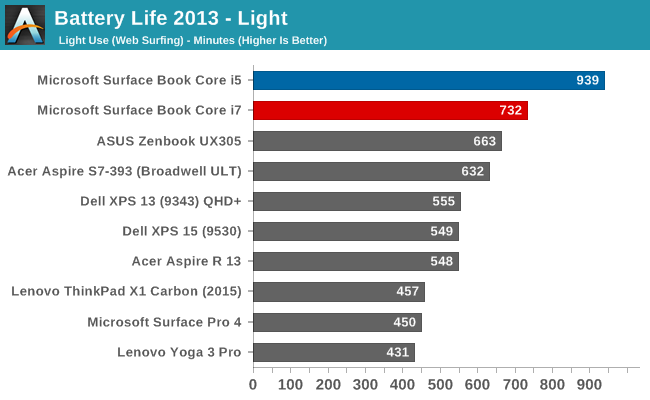
Something amazing happened when I ran the Core i5 Surface Book through our light test. It set a new record for battery life. The amazing part of this is that it did it with a high resolution display, which normally impacts battery life quite a bit. For some contrast, the Dell XPS 13 was our previous battery life leader, but it was the 1920x1080 model. The 3200x1800 version, as seen in the graph above, was quite a bit less. The Core i5 Surface Book got 15.6 hours of battery life in this test. Yes, it was helped by a larger battery, but it was still a very impressive result. The dGPU + Core i7 model took a big hit here, coming in over three hours behind. Without dissecting the device and measuring power draw at each component, it’s tough to lay the blame on any one piece of the puzzle, but it has more RAM, a dGPU with GDDR5 memory (though this should be completely powering down when not in use), and a faster CPU. Any one could be to blame, or a combination of all three. Despite the lower score, at over 12 hours it still did very well on our light test.

The heavy test brings a lot more components into play, making the display power draw a smaller part of the picture. Here we see both the i5 and i7 models doing very well again, but once again the i5 version scores a lot higher. Both models can offer all day battery life, but if outright mobility is a concern, the i5 outperforms the i7 on battery life.
Next, let’s take a look at the platform efficiency, and remove the large 70 Wh of capacity from the equation.
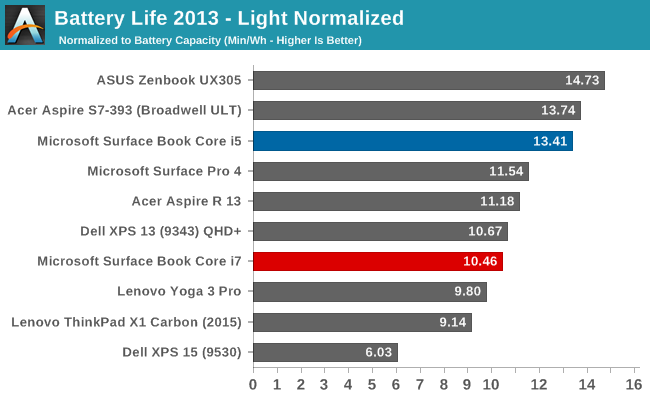
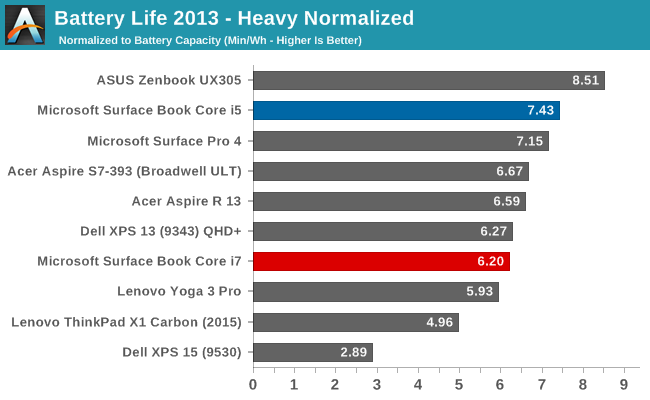
While not the outright leaders in efficiency, the Core i5 Surface Book is the class leader when compared against other high DPI devices. The Core i5 Surface Book has even better efficiency than the Surface Pro 4, despite the Surface Pro 4 using an IGZO panel. On the heavy test, the Core i7 falls back a bit in both tests, but still has a good result.
Connected Standby Support
Surface Book is configured to use Connected Standby, which means that it can pull in app updates and push notifications even when it is sleeping. Out of the box, this is a mixed blessing, since the Surface Book has some issues with Connected Standby at the moment. It is supposed to hibernate after a couple of hours, but that doesn’t always happen, and there seems to be an activity/power drain issue when in sleep, since the Surface Book can get pretty hot when it’s closed. These are serious bugs that mar the experience. You can’t just trust that shutting the lid is going to put the machine to sleep, so if you close the lid and come back the next day, you are going to be welcomed by a dead battery. This is a well known issue, so I would expect a fix soon, but it’s a serious problem with the Surface Book that needs to be pointed out.
Charge Time
With 70 Wh of battery, charge times might be something that will be an issue, so I’ve tested both the Core i5 and the Core i7 models out with their respective adapters that come in the box. Since the Core i7 model includes a GPU, the AC adapter that is supplied is about twice the output of the standard version. The Core i5 comes with a 30 W charger, and GPU models come with a 60 W charger. It’s very difficult to tell which is which, but the 60 W version is slightly thicker, and the charging light on the Surface Connect port has different lighting. The low wattage version has a light that points away from the laptop when connected, and the higher wattage charger has lights that point up and down. You can technically use either charger, or even the Surface Pro 3 or 4 charger, but if you are using the GPU with a 30 W charger, the battery will slowly be depleted since it won’t be able to keep up with demand.
Since there are two batteries, I expected to see the tablet battery charged first and then the base, but that’s not actually what happens. Both are charged simultaneously.
You can see that the 60 W charger on the Core i7 can charge both batteries at the maximum rate simultaneously, but the 30 W charger that comes with the Core i5 charges the smaller tablet battery at maximum first, and when it’s full, sends the rest of the power to the base. It results in a longer charge rate for the non-GPU version.
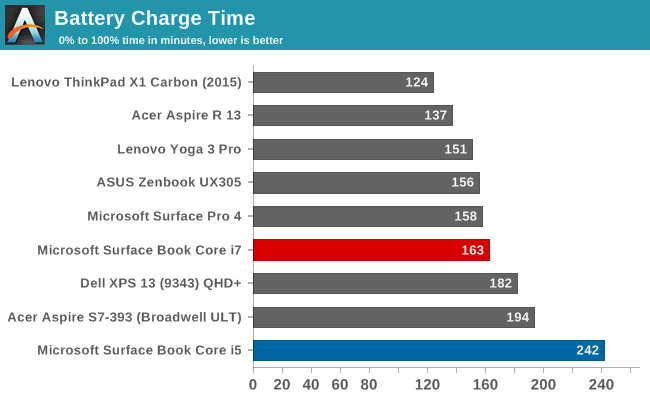
Thanks to including a large 60W power adapter by default, the Core i7 + dGPU version wins by quite a bit, with the non-dGPU model taking nearly four hours to charge to 100% on both batteries. It kind of makes up for that with great battery life, but if you are someone that travels a lot, it may be worth investing in the higher wattage adapter for the non-dGPU version.


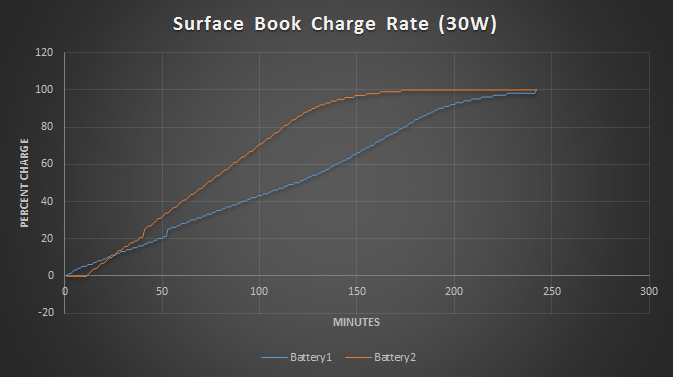
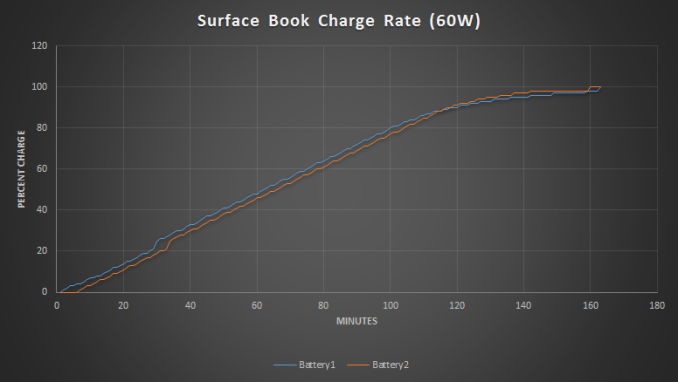








249 Comments
View All Comments
Sc0rp - Saturday, November 14, 2015 - link
1) The iPad Pro is a natural evolution of the iPad line. The surface isn't the only tablet device with split-screen multitasking, accurate pen input isn't something new and Apple had an apple made keyboard since the iPad 1. Apple names ALL of their beefier products "Pro" with the exception of the iPhone. Look at the Macbook PRO and the Mac PRO for examples. Does that mean that you can't do PRO work on a macbook or an iMac? Nope,2) The surface isn't leading the tablet market and it is 'leading' the productivity tablet market in the same way that blackberry 'led' the smartphone market. You know, the same market that has been dwarfed several times over by iPhones and android handsets quickly after the iPhone was released and sorta put RIM out on the street. As for the surface replacing a laptop. Well, a regular laptop is still a much better choice than getting a surface pro.
3) The original FIRST PARTY keyboard for the iPad that was released in 2010 was itself powered by the iPad but it could also be plugged into a computer or wall adapter to charge or sync your iPad. That's what what I meant when i said that the iPad had a keyboard since day one. The Styluses for the iPad aren't all 'fingertip-emulators. Quite a few of them have pressure sensitivity and palm rejection. And look, we are talking about where apple got their ideas. Keyboard cover docks were available for the iPad before the surface was ever even announced, So were styluses. yeah, tablet PC's had styluses, but those styluses didn't use capacitive technology which was the technological challenge for making a stylus for the iPad. The surface pro used to use Wacom digitizers before microsoft bought N-Trig technology to ditch wacom and save some money for the surface pro 3.
I know what the surface pro concept is. Unfortunately it doesn't make for a good laptop or tablet. At least not in comparison to what you get from an actual tablet and an actual laptop.
My entire point is that the iPad Pro wasn't a response to the surface. The iPad Pro is more like apple spreading to other market segments because the mainstream consumer tablet market is drying up pretty fast. Not just for apple but every other tablet manufacturer that appeals to the consumer market. There's really no reason to upgrade your iPad every year or every two years. If you own an iPad 4 right now, there's not much that an iPad Air 2 does that absolutely have to go get it and ditch your 4 and the actual demands from using the device don't necessitate an upgrade. An iPad Air 2 is a demonstrably more powerful and faster device, but the iPad 4 is great as is so far.
Saying that the iPad Pro is a response to the surface is like saying that windows 10 is a response to Linux.
close - Tuesday, November 10, 2015 - link
Or if you actually meant MacBook Pro you may be closer but still, they're different classes. Apple doesn't have anything in this class yet.appleimmune - Tuesday, November 10, 2015 - link
That's about to change..http://money.cnn.com/2015/11/03/technology/apple-m...
Apple, the me too company.
solipsism - Tuesday, November 10, 2015 - link
You took a patent as truth and then claimed Apple was a "me too" company for following a late 2015 MS product with a 2011 patent filing. Brilliant¡Appanage - Tuesday, November 10, 2015 - link
1. Patent filed in 20112. Surface's CPU, chipset, and storage are located under the keyboard? That's news to me.
3. Apple, the "me too" company as you described, was copying off Microsoft with the iPhone? And no, don't say PocketPC unless you expect laughter and discredit.
Sc0rp - Saturday, November 14, 2015 - link
The patent was filed 2 years before the surface pro or surface book were ever announced.WagonWheelsRX8 - Tuesday, November 10, 2015 - link
Yep definitely a nice review. Only wish he included some Apple products in his charts as well (especially the display related ones).Tallface - Tuesday, November 10, 2015 - link
"Where the Surface Book is let down though is on software." ...this. Returned mine last weekend :-(Appanage - Tuesday, November 10, 2015 - link
Exactly. Arguing over chips and hardware superiority is overlooking half the solution, and it's not even the most important half.Krysto - Tuesday, November 10, 2015 - link
> It’s unfortunate that Microsoft did not opt for anything with Intel’s Iris graphics line for the Surface Book like it did for the Surface Pro 4, but the optional NVIDIA GPU more than makes up for it.Why? Do we really want Intel to own 90% of all chip markets?